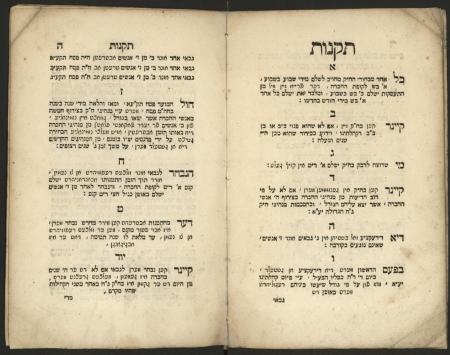Obj. ID: 35449
Jewish printed books Takanot me-Chevrah Kadisha..., Amsterdam, 1811

The following description was prepared by William Gross:
Regulations of the "Chevra Kadisha Gemilut Chassadim "of the Dutch Ashkenasic Community of Amsterdam. Regulations and customs, list of members etc. Amsterdam, 1810. Hebrew and Yiddish. Title page illustrated with bones, a skull and gravediggers tools.
Perhaps the most influential and prestigious holy confraternity was that of the "Chevrah Kadisha", the burial society. This group was charged with seeing to it that every Jew was buried with rigorous attention to the laws pertaining to that act. The most prominent and wealthy citizens often vied with one another to achieve membership in this society, with all its obligations, but also with its great honor. This booklet is an edition of the bylaws for the "Chevra Kadisha" of the Ashkenazi Jews of Amsterdam. On the title page are the symbols of that society and its work, including the skull and cross bones as well as the burning candle and the hourglass, both representing the temporary nature of life. At the bottom are pictured the tools for burial, including the equipment for carrying the body to the grave, the shovel for digging and a charity box. The giving of charity at a funeral is considered a holy obligation. Such societies have existed for many hundreds of years and are active today as well in many Jewish communities. This is the second edition of these bylaws with the same title page, the first having appeared in 1776. These small pamphlets published by different institutions in the cities of Europe, particularly Amsterdam, are the type of material that tends to be very ephemeral. So, such booklets are rare.
The Proops family was involved in the printing of Hebrew books in Amsterdam from the beginning of the 18th century. As the longest lasting such printing house in that city over generations, their publications spanned more than 150 years.
During the nineteenth century, when the Jewish world center of print moved to Eastern Europe, and the social place and function of women improved, there were 24 women active in Hebrew printing and publishing, 17 of whom were in Eastern Europe. A substantial number of printing houses came to be run by widows, the most famous of whom was the Widow (Dvoyre) Romm, who exerted substantial control over the great Lithuanian publishing house from 1860 until her death in 1903. In at least one case, a major Hebrew press, in Lwów, was founded and run from 1788 to 1805 by a woman, Yudis Rosanes, who came from the Żółkiew line of Uri Fayvesh ha-Levi.
16 pp.






